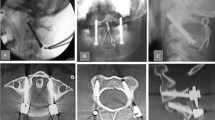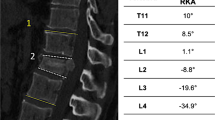Abstract
Purpose
The axis body fractures are relatively uncommon and have a variety of presentations. Surgical management to them has been only reported as case reports or included as a minor part of clinical management. The objective of this study is to summarize the indications for surgery and report the clinical outcome of surgical treatment based on different fracture patterns.
Methods
A retrospective analysis of 28 consecutive patients presenting with the axis body fractures was undertaken. The indications for surgical treatment were defined as: (1) fractures associated with instability of adjacent joints; (2) irreducible displaced superior articular facet fracture; (3) fractures resulting in spinal cord compression. The fractures were classified as sagittal, coronal, transverse and lateral mass fracture. One of the following surgical procedures was applied according to the fracture pattern: posterior C1–C2 pedicle screws fixation and fusion (I); posterior C1–C3 screws fixation and fusion (II); posterior osteosynthesis with C2 transpedicular half-thread lag screws (III).
Results
13 patients were successfully managed operatively. Two transverse and two unilateral lateral mass fractures were treated with surgical procedure I, five sagittal fractures with II, four coronal fractures with III. Complications of malposition of screws and neurologic deficit did not occur during operation. Satisfactory reduction and bony union were demonstrated on postoperative radiographics.
Conclusions
Conservative treatment is still advocated as primary management for most axis body fractures. But for patients with obvious adjacent joints instability or irreducible displaced superior articular facet fracture, surgical intervention based on the different fracture pattern is necessary.





Similar content being viewed by others
References
Starr JK, Eismont FJ (1993) Atypical hangman’s fractures. Spine (Phila Pa 1976) 18:1954–1957
Benzel EC, Hart BL, Ball PA, Baldwin NG, Orrison WW, Espinosa M (1994) Fractures of the C2 vertebral body. J Neurosurg 81:206–212
Fujimura Y, Nishi Y, Kobayashi K (1996) Classification and treatment of axis body fractures. J Orthop Trauma 10:536–540
Hahnle UR, Wisniewski TF, Craig JB (1999) Shear fracture through the body of the axis vertebra. Spine (Phila Pa 1976) 24:2278–2281
Pryputniewicz DM, Hadley MN (2010) Axis fractures. Neurosurgery 66:68–82
Korres DS, Papagelopoulos PJ, Mavrogenis AF, Benetos IS, Kyriazopoulos P, Psycharis I (2005) Chance-type fractures of the axis. Spine (Phila Pa 1976) 30:E517–E520
German JW, Hart BL, Benzel EC (2005) Nonoperative management of vertical C2 body fractures. Neurosurgery 56(516–521):516–521
Jakim I, Sweet MB (1988) Transverse fracture through the body of the axis. J Bone Jt Surg Br 70:728–729
Maki NJ (1985) A transverse fracture through the body of the axis. A case report. Spine (Phila Pa 1976) 10:857–859
Craig JB, Hodgson BF (1991) Superior facet fractures of the axis vertebra. Spine (Phila Pa 1976) 16:875–877
Koller H, Acosta F, Forstner R, Zenner J, Resch H, Tauber M, Lederer S, Auffarth A, Hitzl W (2009) C2-fractures: part II. A morphometrical analysis of computerized atlantoaxial motion, anatomical alignment and related clinical outcomes. Eur Spine J 18:1135–1153
Korres DS, Papagelopoulos PJ, Mavrogenis AF, Sapkas GS, Patsinevelos A, Kyriazopoulos P, Evangelopoulos D (2004) Multiple fractures of the axis. Orthopedics 27:1096–1099
Rainov NG, Heidecke V, Burkert W (1998) Coronally oriented vertical fracture of the axis body: surgical treatment of a rare condition. Minim Invasive Neurosurg 41:93–96. doi:10.1055/s-2008-1052024
Marotta TR, White L, TerBrugge KG, Spiegel SM, Stevens JK, Tator CM (1990) An unusual type of hangman’s fracture. Neurosurgery 26(848–850):850–851
Lozano-Requena JA, Pina-Medina A, Aracil-Silvestre J, Torro-Belenguer V, Baixauli-Castella F (1994) Sagittal fracture of the second cervical vertebral body. Int Orthop 18:114–115
Bohay D, Gosselin RA, Contreras DM (1992) The vertical axis fracture: a report on three cases. J Orthop Trauma 6:416–419
Ma XY, Yin QS, Wu ZH, Xia H, Liu JF, Zhong SZ (2005) Anatomic considerations for the pedicle screw placement in the first cervical vertebra. Spine (Phila Pa 1976) 30:1519–1523
Resnick DK, Lapsiwala S, Trost GR (2002) Anatomic suitability of the C1–C2 complex for pedicle screw fixation. Spine (Phila Pa 1976) 27:1494–1498
Resnick DK, Benzel EC (2002) C1–C2 pedicle screw fixation with rigid cantilever beam construct: case report and technical note. Neurosurgery 50:426–428
Chen JF, Wu CT, Lee SC, Lee ST (2005) Posterior atlantoaxial transpedicular screw and plate fixation. Technical note. J Neurosurg Spine 2:386–392. doi:10.3171/spi.2005.2.3.0386
Lee MJ, Cassinelli E, Riew KD (2006) The feasibility of inserting atlas lateral mass screws via the posterior arch. Spine (Phila Pa 1976) 31:2798–2801. doi:10.1097/01.brs.0000245902.93084.12
Burke JT, Harris JJ (1989) Acute injuries of the axis vertebra. Skeletal Radiol 18:335–346
Effendi B, Roy D, Cornish B, Dussault RG, Laurin CA (1981) Fractures of the ring of the axis. A classification based on the analysis of 131 cases. J Bone Jt Surg Br 63-B:319–327
Andrews RJ (1990) Hangman’s fractures involving the body of C2. Neurosurgery 27:845–846
Levine AM, Edwards CC (1985) The management of traumatic spondylolisthesis of the axis. J Bone Jt Surg Am 67:217–226
ElMiligui Y, Koptan W, Emran I (2010) Transpedicular screw fixation for type II Hangman’s fracture: a motion preserving procedure. Eur Spine J 19:1299–1305. doi:10.1007/s00586-010-1401-2
Rajasekaran S, Tubaki VR, Shetty AP (2012) Results of direct repair of type 2 hangman fracture using Iso-C3D navigation: 20 cases. J Spinal Disord Tech 25:E134–E139. doi:10.1097/BSD.0b013e31825bcfe9
Hakalo J, Wronski J (2008) Operative treatment of hangman’s fractures of C2. Posterior direct pars screw repair or anterior plate-cage stabilization? Neurol Neurochir Pol 42:28–36
Anderson LD, D’Alonzo RT (1974) Fractures of the odontoid process of the axis. J Bone Jt Surg Am 56:1663–1674
Acknowledgments
No funds were received in support of this article. No benefits in any form have been or will be received from a commercial party related directly or indirectly to the subject of this manuscript.
Conflict of interest
None.
Ethical standards
This study was approved by the Institutional Review Board and the Ethics Committee of our institution.
Author information
Authors and Affiliations
Corresponding authors
Rights and permissions
About this article
Cite this article
Zhang, YS., Zhang, JX., Yang, QG. et al. Surgical management of the fractures of axis body: indications and surgical strategy. Eur Spine J 23, 1633–1640 (2014). https://doi.org/10.1007/s00586-013-3158-x
Received:
Revised:
Accepted:
Published:
Issue Date:
DOI: https://doi.org/10.1007/s00586-013-3158-x




